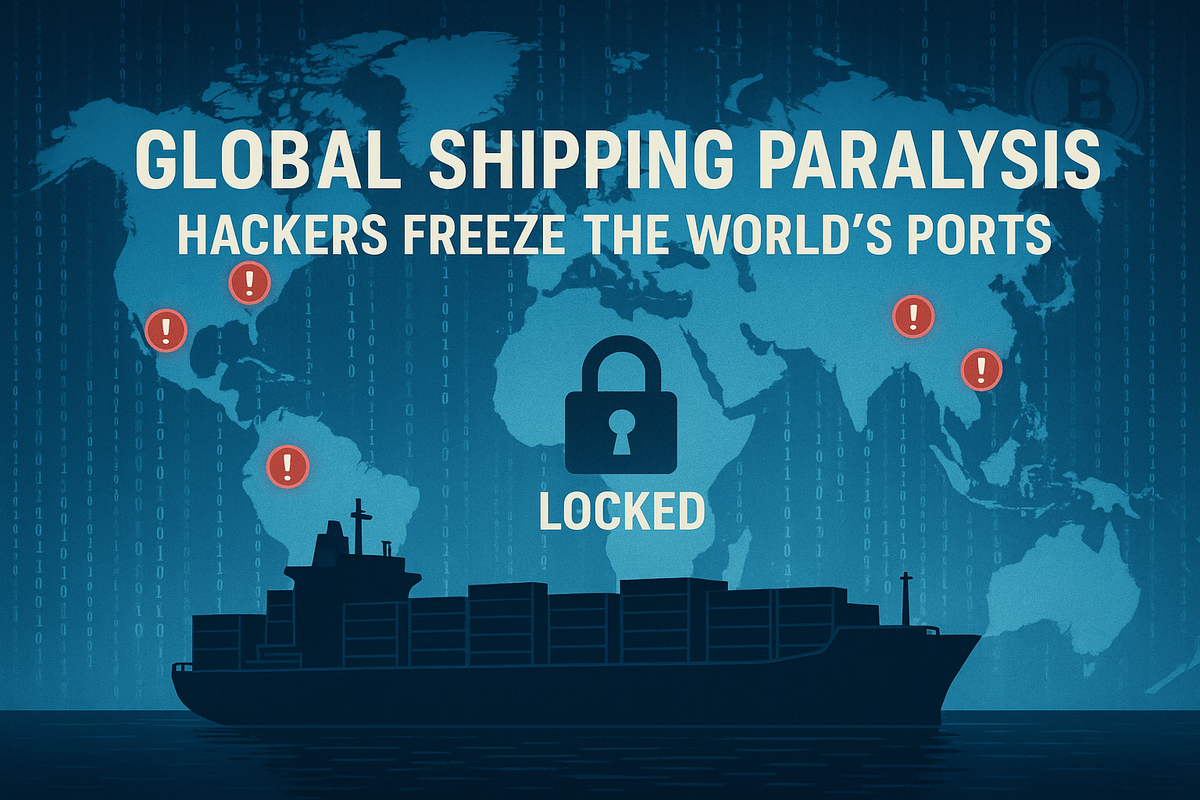Global Shipping Crisis After Cyberattack: Hackers Cripple World’s Largest Port Network Supply Chains in Chaos
A massive cyberattack has crippled the world’s largest port network, paralyzing global shipping routes. Container backlogs, soaring costs, and supply chain chaos threaten critical goods from electronics to food.

Introduction: A Shockwave Through Global Trade
July 12, 2025, was a sultry morning at the Port of Singapore, Asia's most vital shipping nexus. Suddenly, the complex suddenly fell silent. Error codes flashed on monitors in the nerve center that tracks hundreds of thousands of containers. Cranes at docks hung suspended mid-air, steel containers clutched like toys. Ships that had been creeping up to berths were told to anchor offshore.
By noon, one fact was unmistakable:
A gigantic ransomware attack had paralyzed the center of the international shipping network.
In a matter of hours, cargo flows in Shanghai, Rotterdam, Hamburg, Felixstowe, and other mega-hubs ground to a halt. The attackers, presenting themselves as the Sable Hydra Collective, made a demand: Pay $500 million in Bitcoin in ransom, or see world trade remain in limbo forever.
In a time of just-in-time supply chains and electronic logistics, this one attack risked unraveling the intricate machinery of the new economy.
The Attack: Anatomy of a Digital Siege
How It Began
As told by forensic experts at FireEye Mandiant, the break-in most likely began as early as late May 2025. The hackers conducted a targeted spear-phishing campaign that deceived port authority staff into opening weaponized attachments posed as harmless documents purchase orders, customs forms, and shipping confirmations.
The attackers used inside the systems:
- Custom malware loaders that bypassed antivirus software.
- A zero-day exploit in a commercially popular container logistics platform—the details of which are still classified.
- Remote control weapons to raise privileges over networks.
On July 12, Sable Hydra carried out the ultimate payload: a variant of ransomware known as BlackStorm-5, an advancement of previous versions employed in attacks on the energy industry. In contrast to earlier ransomware, BlackStorm-5 was designed to:
- Encrypt data and backups, leaving victims with no means to restore systems.
- Disable monitoring software to hide extent of compromise.
- Lock automated cranes and port IoT devices, essentially stopping physical functions.
This coming together of cyber and physical paralysis resulted in the incident being unparalleled in magnitude.
Ports around the World Grounded to a Halt
The ports that were impacted had the largest arteries of commerce:
- Port of Singapore: Handling more than 37 million containers each year.
- Port of Shanghai: China's top export hub.
- Port of Rotterdam: Europe's gateway of logistics, exporting oil, grain, machinery, and more.
- Port of Hamburg: An important source of European auto and electronics imports.
- Felixstowe Port: The biggest container port of the UK.
Satellite images released by MarineTraffic and Sentinel-2 revealed container vessels moored in extended lines off-shore some of which were seen from coastal roads.
A Rotterdam senior logistics manager explained it bluntly:
"We lost track of every container within less than 15 minutes."
The Sudden Economic Shockwave
Today's modern supply chains are engineered for efficiency but not resilience. This is how the crisis unfolded:
Retail and Manufacturing
- Electronics: More than 70% of Asian consumer electronics exports go through Singapore and Shanghai. German and Mexican factories started reducing production levels because of delayed parts.
- Automotive: Wolfsburg, Turin, and Detroit factories were compelled into rolling shutdowns.
- Retail: U.S. and EU big-box retailers such as Walmart and Carrefour initiated rationing of popular products.
Food and Pharmaceuticals
- Imported fresh produce shipments spoiled in containers waiting for customs clearance.
- Pharmaceuticals shipped in cold chains were stuck in ports in warehouses.
- African and Middle Eastern importers cited desperate shortages of staple grains.
Commodities and Energy
- European refinery-bound oil tankers were rerouted, sending Brent crude futures up 8% in 48 hours.
- Copper and rare earth shipments needed for EV manufacture came to a halt, fueling commodity price swings.
Every 24 hours of idleness cost the world economy $1.2–1.5 billion, estimated the World Shipping Council.
Inside the Ransom Demand
Sable Hydra issued a statement via dark web Tor forums, stating:
“The world profits from your complacency. This is your tax for ignoring systemic risk.”
They demanded $500 million in Bitcoin by July 19 and threatened to:
- Permanently delete all cargo and logistics data.
- Leak sensitive contracts and shipment details.
- Wipe operational technology firmware, effectively bricking the cranes and sensors.
Cybersecurity experts detected wallet addresses associated with earlier ransomware attacks against the energy and transportation industries. Through July 16, no significant sums had been seen transferring to those wallets.
Why Ports Became a Prime Target
1. Complex, Legacy Systems
Ports around the world operate decades-old layers of software—a combination of proprietary crane controls, 1990s-era Windows servers, and cloud dashboards. Security scans have continued to point to:
- Insufficient network segmentation (IT and OT networks frequently completely interconnected).
- End-of-life operating systems.
- Poor password policy.
A 2024 report by Lloyd's Register determined that 42% of the world's major ports still operated using unpatched systems.
2. Interconnected Global Networks
Container shipping is a symphony of:
- Automated yard cranes
- IoT devices monitoring container temperature and location
- Cloud platforms managing customs, payment, and logistics
When a node fails, the disruption propagates worldwide.
3. Chronic Underinvestment
While carriers poured money into automation, cybersecurity budgets lagged behind. Insurance giant Marsh McLennan estimated that maritime cybersecurity spending grew only 3% annually since 2019 even as attacks surged 58% in 2023 alone.
Global Response: Governments Scramble
Within hours, governments and industry leaders moved to limit the damage:
Emergency Measures
- Singapore: Activated the Maritime Cybersecurity Command Centre, working 24/7 with European and U.S. counterparts.
- European Union: Launched EU CYBR-PORT, a rapid-response incident team.
- NATO: Put its Cyber Rapid Reaction Force on standby.
- United States: DHS and CISA coordinated on intelligence-sharing with the IMO.
Partial Restoration of Services
Limited services resumed in Hamburg and Rotterdam by July 15 through:
- Isolated manual processing terminals.
- Air-gapped crane control fallback systems.
- Paper-based customs clearance reducing throughput by 90%.
It was warned that it would take 4–6 weeks to fully recover normal services.
Greater Economic and Geopolitical Consequences
This incident laid bare structural weaknesses in the global economy:
1. Inflationary Pressures
Goldman Sachs and OECD economists predict:
- A 0.3–0.5% rise in world inflation in case the crisis continues into August.
- Sudden spikes in electronics, machinery, and food prices.
2. Insurance and Legal Consequences
- Maritime insurers are dealing with claims of over $10 billion, which is many times higher than past cyber attacks.
- Shipper suits are being planned over delayed shipments and rotting cargo.
- Governments are drawing up emergency subsidies for key industries.
3. Geopolitical Tensions
- China suggested unnamed "foreign actors" could have enabled the attack.
- U.S. intelligence is probing potential state-sponsored involvement.
- Smaller import-reliant economies are staring into imminent food security crises.
Could This Have Been Prevented?
Maritime cybersecurity professionals insist the answer is yes and have been warning about it for years:
- Following the 2022 U.S. East Coast port attack, Senate hearings yielded a 300-page report calling for upgrades. The majority of the recommendations were put on the backburner.
- A 2023 World Bank white paper approximated $3 billion of cybersecurity investment would have minimized maritime cyber threats by 70%.
A port CTO summed up the crisis in a nutshell:
"We designed the most efficient supply chain ever—and forgot to lock it up."
Voices from the Front Lines
Captain Markus Lorenz, in command of a Maersk Triple-E ship:
"We've waited offshore for five days. We don't even know which port to go to next."
Ana Gutierrez, a German carmaker's logistics director:
"We had squeezed every last cent out of the supply chain for years. Now the bill comes due."
Reena Patel, dockworker at Rotterdam:
"We can't even move the cranes because everything is blocked. It's frightening how fast everything collapsed."
What Happens Next?
Recovery Timeline
According to port statements:
- Week 1–2: Manual operations partly restored.
- Week 3–4: Systems scrubbed, reinstalled, and tested.
- Week 5+: Normal throughput resume incrementally.
In parallel, redirected vessels are clogging secondary ports, establishing secondary bottlenecks in the Indian Ocean, Gulf of Mexico, and Mediterranean.
Cybersecurity Reboot In Progress
Industry players and governments are now exploring:
- Requiring minimum standards, including:
- Air-gapped backup networks
- Multi-factor authentication
- Real-time threat monitoring
- Global Cyber Rapid Response Teams:
- Deployable task forces similar to disaster response teams.
- Cyberinsurance Regulation:
- New constructs for covering catastrophic cyber losses.
Lessons for the Future
This incident has shed light on the vulnerability of globalization. The lessons are stark:
- Resilience without efficiency is a weakness.
- Digital security underinvestment has the potential to annihilate decades of progress in a single night.
- Cybercrime is fast becoming a disruptor that can bring down entire continents.
For governments and businesses alike, this is a line in the sand moment: change or face a repeat perhaps worse.
Conclusion
The Sable Hydra attack is not merely a shipping emergency. It is a stark reminder of our vulnerability to brittle computer systems with inadequate protection. As governments scramble to plug holes and businesses hurry to restore trade, the world is seeing a new era of economically enabled cyber-war.
Only time will tell if this crisis will spur permanent changes or dissipate as yet another cautionary tale unheeded until the next disaster.
Sources
- CourtListener: U.S. v. Marcus Hutchins
- Justia: Maritime Cybersecurity Regulations
- Archive.org: Lloyd’s Register Cybersecurity Report 2024
- Google Trends: “Port Cyberattack July 2025” Search Trends
- Official Press Releases:
- Port of Singapore Authority, July 12, 2025
- International Maritime Organization, July 13, 2025
- Financial Times: Global Trade Faces Unprecedented Disruption
- Reuters: Shipping Chaos Deepens After Port Cyberattack
- Bloomberg: Ransomware Hits Global Shipping
- The Guardian: Ports Brought to Standstill
- Nikkei Asia: Asia’s Exports Frozen
For more legal exposes and truth-behind-glamour stories, subscribe to AllegedlyNewsNetwork.com




